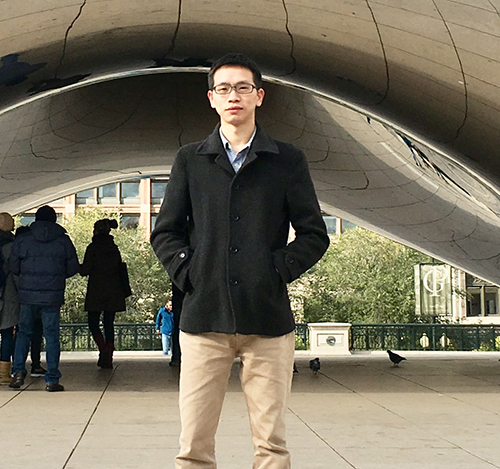Youjun Zhang, Professor

Youjun Zhang
Ph.D., Full Professor
Email: zhangyoujun@scu.edu.cn
Address: 24, South Section 1, Yihuan Road, Chengdu
Dept.: Institute of atomic and molecular physics.
Education
Ph.D., Graduate School of Science, Hiroshima University, Higashi-Hiroshima, Japan, 2015
B.S., School of Power and Energy, Northwestern Polytechnical University, Xi'an, China, 2009
Biography
Dr. Y.J. Zhang is a full professor at Institute of Atomic and Molecular Physics, Sichuan University. Dr. Zhang received his B.S. degree in Aircraft Engine Engineering from Northwestern Polytechnical University, China, in 2009, and Ph.D. degree in Earth and Planetary Systems Science from the Hiroshima University, Japan in 2015. His main research field is the high pressure mineral physics and condensed matters physics.
Research Areas
My research interests mainly focus on understanding high pressure physics of the condensed matters, high pressure mineral physics of the Earth and planetary bodies, and dynamic behaviors of materials through directly experimental observations and modeling using some state-of-art electrical, optical, and x-ray diagnosis. My research career is to study the physics, chemistry, and mechanics of materials under high pressure-temperature conditions to reveal the secrets of nature.
Grants and Projects
1. NSFC, Melting behaviors of iron alloyed with multiple light elements under Earth’s core conditions: implications for the thermal structure and light element partitioning of the core. 2021-2024, PI
2. NSFC, Transport properties in Fe and Fe alloys at high pressure-temperature and implications for thermal evolution of the Earth's core. 2019-2021, PI
3, NSFC, Experimental and theoretical studies on the lattice dynamics and physical mechanics of transition metals at high pressures. 2019-2022, Co-PI
Professional Honors and Awards
2020, Distinguished expert by Sichuan government, China
March 2015, Distinguished Achievement Awardee of Graduate School of Science, Hiroshima University, Japan;
May 2012, China Scholarship Council Award, Ministry of Education of the People’s Republic of China, China;
Selected Publications
Publication list:
Google Scholar: https://scholar.google.com/citations?hl=en&user=O4hlowkAAAAJ
ORCID: http://orcid.org/0000-0001-5340-4170
(15 selected peer-reviewed papers, * Corresponding)
1. Y. Huang, M. Hou, B. Gan, X. Li, D. He, G. Jiang, Y. Zhang*, and Y. Liu, Iron-carbon alloy under shock compression: implications for the carbon concentration in Earth’s inner core. Journal of Geophysical Research: Solid Earth, 127(4), e2021JB023645, (2022)
2. X. Li, C. Yang, B. Gan, Y. Huang, Q. Wang, T. Sekine, J. Hong, G. Jiang*, and Y. Zhang*. Sound velocity softening in body-centered cubic niobium under shock compression. Phys. Rev. B, 105(10), 094105, (2022)
3. C. Yang, Y. Zhang*, N. Salke, Y. Bi, A. Alatas, A. Said, J. Hong*, and J.-F. Lin*. Kohn anomaly and elastic softening in body-centered cubic molybdenum at high pressure. Phys. Rev. B, 105(9), 104110, (2022).
4. Y. Zhang* and J.-F. Lin*, Molten iron in Earth-like exoplanet cores. Science, 375(6577), 146-147, doi: 10.1126/science.abn2051, (2022).
5. Y. Zhang#, K. Luo#, M. Hou#, P. Driscoll, N. Salke, J. Minár, V. Prakapenka, E. Greenberg, R. J. Hemley*, R. E. Cohen*, and J.-F. Lin*. Thermal conductivity of Fe-Si alloys and thermal stratification in Earth’s core. Proceedings of the National Academy of Sciences (PNAS), 119(1), e2119001119, (2022).
6. Y. Zhuang#, B. Gan#, Z. Cui, R. Tang, R. Tao, M. Hou, G. Jiang, C. Popescu, G. Garbarino, Y. Zhang*, Q. Hu*. Mid-mantle water transportation implied by the electrical and seismic properties of ε-FeOOH. Science Bulletin, 67, 748-754, doi: 10.1016/j.scib.2021.12.002 (2022).
7. B. Gan, Y. Zhang*, Y. Huang, X. Li, Q. Wang, J. Li, Y. Zhuang, Y. Liu, G. Jiang. Partial deoxygenation and dehydration of ferric oxyhydroxide in Earth's subducting slabs. Geophysical Research Letters, 48(17), e2021GL094446 (2021).
8. M. Zhao, Z. Kou*, Y. Zhang*, B. Peng, Y. Wang, Z. Wang, X. Yin, M. Jiang, S. Guan, J. Zhang, D. He. Superhard transparent polycrystalline cubic boron nitride. Applied Physics Letters. 118(14), 151901, doi: 10.1063/5.0045545 (2021).
9. Y. Zhang*, M. Hou, P. Driscoll, N. Salke, J. Liu, V. Prakapenka, E. Greenberg, and J.-F. Lin*. Transport properties of Fe-Ni-Si alloys at Earth's core conditions: Insight into the viability of thermal and compositional convection. Earth and Planetary Science Letters, 553, 116614, http://doi.org/10.1016/j.epsl.2020.116614, (2021).
10. Y. Zhang, Y. Tan, H. Y. Geng, N. Salke, Z. Gao, J. Li*, T. Sekine, Q. Wang, E. Greenberg, V. Prakapenka, and J.-F. Lin*. Melting curve of vanadium up to 256 GPa: consistency between experiments and theory. Physical Review B. 102(21), 214104, https://doi.org/10.1103/PhysRevB.102.214104, (2020).
11. J. Li, Q. Wu, J. Li, T. Xue, Y. Tan, X. Zhou, Y. Zhang*, Z. Xiong, Z. Gao, and T. Sekine. Shock melting curve of iron: a consensus on the temperature at the Earth's inner core boundary. Geophysical Research Letters. 47(15), e2020GL087758, https://doi.org/10.1029/2020GL087758 (2020).
12. Y. Zhang#, M. Hou#, G. Liu, C. Zhang, V. Prakapenka, E. Greenberg, Y. Fei, R. E. Cohen*, and J.-F. Lin*. Reconciliation of experiments and theory on transport properties of iron and the geodynamo. Physical Review Letters, 125(7), 078501, doi: 10.1103/PhysRevLett.125.078501, (2020).
13. Y. Zhang*, P. Nelson, N. Dygert, and J.-F. Lin*, Fe alloy slurry and a compacting cumulate pile across Earth's inner-core boundary. Journal of Geophysical Research: Solid Earth, 124 (11), 10954-10967, doi: 10.1029/2019JB017792 (2019).
14. Y. Zhang, C. Yang, A. Alatas, A. Said, N. Salke, J. Hong*, and J.-F. Lin*. Pressure effect on Kohn Anomaly and Electronic Topological Transition in Single-Crystal Tantalum, Physical Review B, 100 (7), 075145 (2019).
15. Y. Zhang, T. Sekine*, J.-F. Lin, H. He, F. Liu, M. Zhang, T. Sato, W. Zhu, and Y. Yu. Shock Compression and Melting of an Fe‐Ni‐Si Alloy: Implications for the Temperature Profile of the Earth's Core and the Heat Flux Across the Core‐Mantle Boundary. Journal of Geophysical Research: Solid Earth, 123(2): 1314-1327 (2018).
